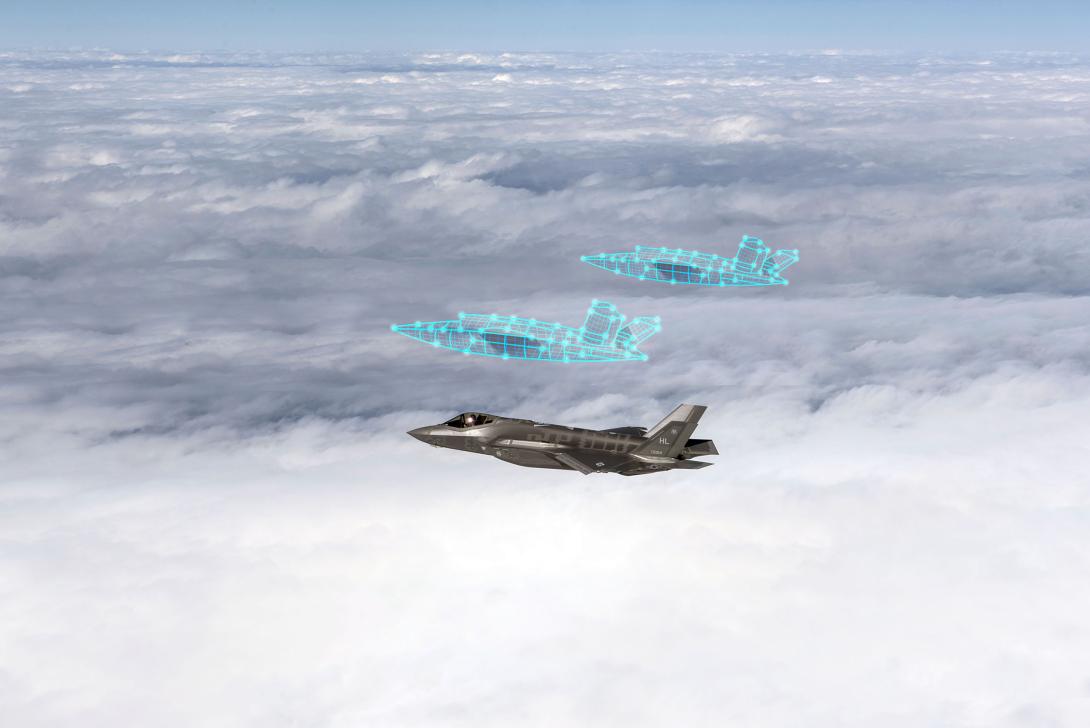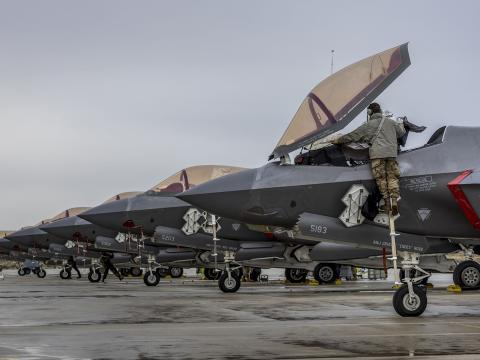Collaborative Combat Aircraft Shift Paradigms and Present Challenges
Not since the application of airplanes to combat warfare over 100 years ago has the U.S. military seen a shift in how it will defend the air domain with the addition of the U.S. Air Force’s Collaborative Combat Aircraft, or CCAs. More than a drone, CCAs could provide the service with exponential power in the air and tactics not yet fully envisioned, leaders say.
However, the Department of the Air Force must meet the difficult challenge it set for itself to acquire and field CCAs over the next several years. The Air Force seeks to quickly add CCAs—unmanned, autonomous aircraft equipped with advanced sensors or weapons that can communicate real time with other airborne vehicles and ground assets in a highly contested environment.
“We’re moving forward with a sense of urgency on CCAs,” said U.S. Air Force Secretary Frank Kendall, speaking to reporters on February 13 in Aurora, Colorado, during a media roundtable at the Air and Space Force Association’s (AFA’s) Warfare Symposium.
The service plans to begin its CCA Program of Record next fall, during the first quarter of fiscal year 2025. However, the lofty goal of fielding thousands of CCAs comes at a time of congressional budgetary failures and possible supply chain issues. The Air Force also must alter its warfare approach, aircraft processes, training and culture to incorporate CCAs.
“As we’re looking at force design and campaign level analysis through our war games and other activities, CCA is one of those exemplars of something that’s extraordinarily disruptive to the way we have traditionally done things,” said Maj. Gen. R. Scott Jobe, director, Force Design, Headquarters Air Force, speaking to airmen and industry during a panel at AFA. “Everything from human-machine teaming to what skills an airman needs in the future, which involves a lot of data, analytics, software, programming at the tactical edge. That all affects the human part of our Air Force and Space Force. There is a human-machine teaming aspect of CCAs that is disruptive internally to us.”
However, Congress’ inability to perform its statutory job of passing an annual military budget on time has already hurt the CCA effort, given the “significant” amount of increased funding slated for the program for fiscal year 2024, which should have been provided last October. The CCA program is only one of many key efforts designed to defend against China, Russia and other adversaries that have been negatively impacted by Congress, according to Secretary Kendall.
In addition, the Air Force must overcome the challenges of pursuing CCAs through a nontraditional acquisition process. It is a new approach, explained Brig. Gen. Jason Voorheis, program executive officer for Fighters and Advanced Aircraft, Air Force Life Cycle Management Center, Air Force Materiel Command, Wright-Patterson Air Force Base, Ohio, also speaking on a panel at AFA. Gen. Voorheis oversees the development, production, fielding, sustainment and modernization of the Air Force’s fighter portfolio, which includes the CCA program, the Next Generation Air Dominance program, the A-10, F-15, F-16, F-22 and other special programs.
The acquisition approach includes the concept of government-owned architectures, leveraging an industry consortium, relying on shared development environments, and “sustained competition” on the air vehicle and mission systems and autonomy levels, he said. The service is also emphasizing low-cost vehicles.
To leverage competition, the service will contract for various components and services in increments from the consortium of about 30 companies. The CCA Consortium includes traditional original equipment manufacturers (OEMs) that will compete to manufacture the aircraft and engines, along with the command and control, mission systems, autonomy and software development.
The Department of the Air Force expects the consortium “to continue to expand over time to sustain a vibrant, competitive marketplace,” said Gen. Voorheis. The Air Force is also planning to leverage nontraditional companies and small businesses.
Yet, the key to create this powerful warfare optionally rests on the department’s ability to clearly represent what it needs in terms of CCA capabilities to the consortium as well as an adroit selection of the companies that will build the CCAs. The types of CCAs could range in size and engine power and mission application. And the service has not yet decided on requirements for the airborne vehicle and related systems.
In November 2023, the Air Force Material Command collected industry responses from its “Future Collaborative Combat Aircraft Request for Information” about possible CCA engine options that could be either commercial off-the-shelf, modified off-the-shelf, derivative or new engine designs. The request also asked about engines with a possible 3,000 to 8,000 pounds of thrust.
Air Force Material Command asked for information on CCAs that would fit into its Agile Combat Environment, or ACE, approach. The service has spent the last several years transforming its operation from a large-base approach to a new paradigm of smaller, more agile groups of airmen and aircraft to move stealthily around the world, especially in the Indo-Pacific.
“For the purpose of this response, the desired aircraft characteristics of interest for evaluating the enabling capabilities of the engine’s options are as follows: increased range, reduced runway take-off distance, increased Mach capability, increased power and thermal capacity, and increased payload,” the request for information indicated.
At the February AFA conference, Secretary Kendall announced that for Increment 1 of the CCA program, the service would select two to three companies from the five that it had already placed on contract—Anduril, The Boeing Company, General Atomics, Lockheed Martin and Northrop Grumman—to move to the next phase of that increment.
“We are doing it with both increments, Increment 1 and Increment 2, from the five-year plan that we formulated and funded and defined,” Secretary Kendall told reporters. “As a preamble, everything depends on fiscal year 2024 funding. We have a big increase in funding coming in FY 24. Moving forward, within just the next few months, we’re going to go from the five [companies] we have on contract to a smaller number. We are going to have at least two. We’d like to have three. Three is going to be difficult because the level of funding we have in the budget, but with some cost sharing with industry, I think we could do three and that will be our preference.”
Meanwhile, Increment 2, which will also involve international partnerships with allies and other nations, is moving forward, Secretary Kendall said.
From the OEMs’ points of view, companies are energized and confident that they can provide the types of CCA capabilities that the Air Force needs, according to officials who presented on an AFA panel. David Alexander, president of General Atomics Aeronautical Systems, noted that open mission systems and open architectures would be key to moving forward in the competition. That includes command and control and sensors systems, he said. And to grow this level of autonomy and artificial intelligence, companies should have the flexibility to iterate quickly and to experiment with new capabilities without having an airworthiness cycle every time. “That is where you are really going to grow your autonomy and AI,” he noted.
And since the fundamental challenge of the CCA program is low cost versus exquisite, expensive aircraft, manufacturers will have to look at and present “low cost as a technology, as a capability,” Alexander stated. To produce the high numbers of CCAs—thousands—companies will also have to adroitly manage their supply chains, which may be one of the “greatest challenges,” he noted. While building out that supply base emphasized low-cost manufacturing, it will be helpful for companies to have frequent forecasts from the Air Force on the volume/quantity cycles of needed CCAs.
“The CCA program is prioritizing simplicity, affordability and mass,” Alexander stated. “For that speed to capability ... companies have to have confidence in what they are designing to be able to go straight into production, and the speed to get the right sensor systems with open architecture, so that the system can grow in the future. And don’t underestimate the global supply chain significance of this ... and getting parts and kitted in the right place, in the time scale that the Air Force” will be asking manufacturers to meet.
Mark Rettig, executive director, Business and Technologies Development, GE Aerospace, noted that the Air Force and the manufacturers will have to be “pioneers” given the novelty of designing in this low-cost environment. Tom Jones, corporate vice president and president of the Aeronautics Systems Sector, Northrop Grumman, emphasized that CCAs are a transformational capability for the Air Force. To be a successful program, airmen will need to be able to experiment early on with initial units of CCAs. And then, like with the B-21, the first CCA aircraft prototypes should be as close to production level as possible, “as close to operationally relevant as possible,” he suggested. “We have to figure out how to make thousands of these and do it very efficiently and quickly.”
Jones also warned that “getting autonomy right” was not always easy and that the Air Force would need “operationally robust autonomy” at levels not seen before.
At the same time, the Air Force will have to facilitate getting CCA prototypes quickly “into the hands of our test operator community,” Gen. Voorheis said. This will help the service as it innovates crewed and uncrewed teaming concepts. “We have to understand how best to integrate CCAs into the force structure across the full spectrum of doctrine, training, policy and leadership,” he stated



